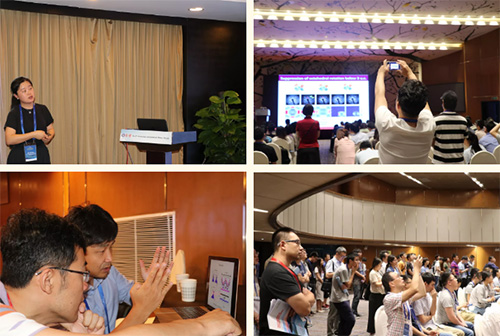IOP Holds the 5th Conference on Condensed Matter Physics
Date:20-09-2019 Print
The 5th Conference on Condensed Matter Physics (CCMP), co-sponsored by the Institute of Physics (IOP), Chinese Academy of Sciences (CAS), Shanghai Jiaotong University and Fudan University, with the support of Yangtze River Delta Physics Research Center, and organized by the Academic Service Department of IOP, was held at Hantian Hotel, Liyang City, Jiangsu Province from June 28 to 30. Over 900 experts and scholars from China, South Korea, Japan, Singapore, India, Germany, the US and Canada attended the conference to discuss important frontier scientific issues and the latest progress in condensed matter physics and related interdisciplinary subjects. CAS Academician Xiang Tao delivered a welcome speech on behalf of the Organizing Committee. Prof. Can-Ming Hu, a famous scholar from Canada, and CAS Academician Ouyang Qi of Peking University gave excellent lectures. CAS Academician Xie Xincheng and CAS Academician Gong Xingao were also present at the conference.
The CCMP has eight parallel sessions, including Unconventional Superconductivity, Strongly Correlated Systems and Machine Learning, Quantum Computations and Cold Atoms, Twisted Bilayer and Multi-layer Graphene Systems, Low-dimensional and Artificial Microstructure Physics, Topological Quantum Systems, Statistical Physics and Soft Condensed Matter Physics, Multiferroic Physics and Quantum Magnetism, and Computational Condensed Matter Physics and Its Applications. The first four were English sessions. The conference featured 282 high-level invited lectures.
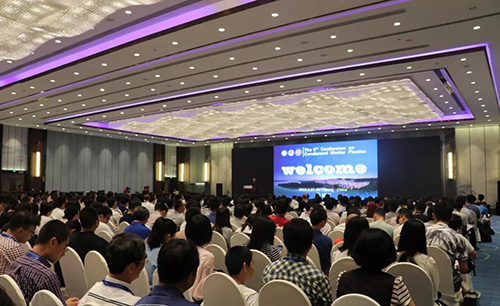
Professor Can-Ming Hu of the University of Manitoba, Canada, delivered an invited lecture entitled "Cavity Spintronics". Cavity spintronics is a new interdisciplinary subject, which studies photons in resonant cavities, spin excitations in solid materials (such as magnetons), and the strong coupling between them. Based on quantum entanglement or classical electromagnetic coupling, and the interaction between magnetons and photons, modern quantum information and quantum optics are closely connected with ancient magnetism. By analogy of two different types of coupled harmonic oscillators, Prof. Hu described in simple language two main research directions of this new discipline: (1) coherent magneton-photon coupling, from which the mode conversion technology was developed, and the techonology can be applied to quantum information, quantum magnetism and spintronics. (2) dissipative magneton-photon coupling, from which applications such as topological energy transfer, quantum sensing, and unidirectional photon transfer can be expected to be developed.
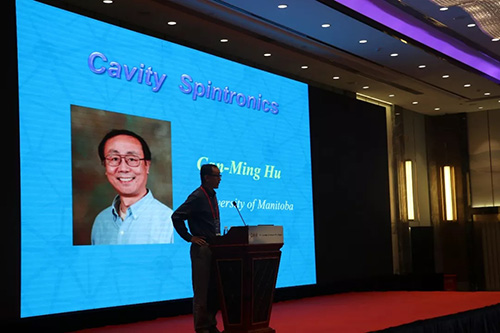
Academician Ouyang Qi of Peking University delivered an invited lectured entitled "The free energy cost of biological circular clock". Complex biological systems provide physicists with many examples of information processing in nonequilibrium systems. The life oscillation network is the timer of life, which regulates all kinds of life processes related to time information. However, in the cellular environment, the oscillation phase fluctuates under the impact of internal and external noises, making the oscillation process very imprecise. In his lecture, Prof. Ouyang focused on different types of circadian clocks and for the first time theoretically explained the universal relationship between the accuracy, sensitivity, and synchronization of circadian clock oscillation and their free energy dissipation.
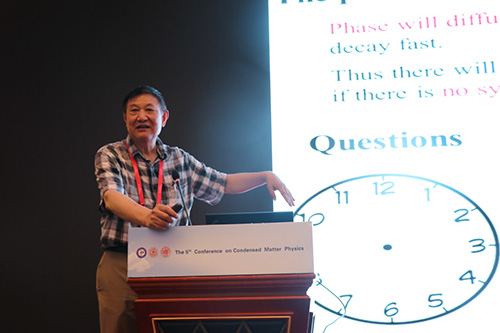
The editorial board of China Physics Letters (CPL), the flagship journal of the Chinese Physical Society (CPS), invited Academician Gong Xingao of Fudan University to give a special lecture entitled "Hybrid halide perovskite semiconductor for solar cell: a perspective view from a computational physicist" at the 8th session in recognition of the outstanding authors who have made important contributions to the development of CPL. On the session, Academician Xiang Tao, deputy chief editor of CPL, presented Academician Gong Xingao the honorary certificate for invited lecture.
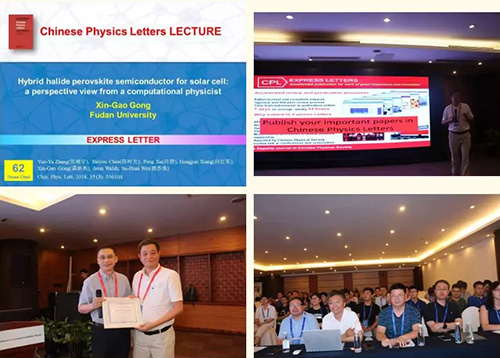
A total of 136 posters were submitted from participants at home and abroad. In the end, 13 posters were selected as excellent posters, 6 of which received double rewards for containing original work recently published in the four major journals (CPL, CPB, Acta Physica Sinica, and Physics).
Domestic participants of CCMP-2019 were mainly from IOP CAS, Peking University, University of Science and Technology of China, Tsinghua University, Fudan University, Shanghai Jiaotong University, Nanjing University, University of Chinese Academy of Sciences, Nankai University, Jilin University, Zhejiang University, Wuhan University, Huazhong University of Science and Technology, Sun Yat-sen University, Beijing Normal University, Shanxi University, Tongji University, Xiamen University, Lanzhou University, Renmin University of China, Beijing Institute of Technology, Institute of Semiconductors of CAS, High Magnetic Field Laboratory of CAS, Wuhan National High Magnetic Field Center, Beijing Computing Science Research Center, Wuhan Institute of Physics and Mathematics of CAS, Beijing Computational Science Research Center, Wuhan Institute of Mathematics and Physics, Chinese Academy of Sciences, Hong Kong University of Science and Technology, Hong Kong University, Chinese University of Hong Kong, and other research institutions.
The first CCMP was held in 2015 co-sponsored by Tsinghua University, Collaborative Innovation Center of Quantum Matter (CICQM), IOP CAS and Peking University; the second CCMP was organized by Nanjing University; the third and fourth conferences were co-sponsored by IOP CAS, Shanghai Jiaotong University, and Fudan University.
During the short event filled with excellent lectures, extensive exchanges and in-depth discussions, experts and scholars inside and outside China shared their latest research achievements with great passion, yielding fruitful results. With our joint efforts, CCMP will attract more and more attention and active participation of international peers, which is expected to boost the development of condensed matter physics and its related interdisciplinary frontier fields.
Hope to meet you again at CCMP-2020!
